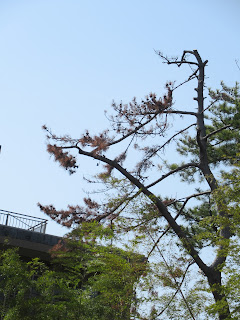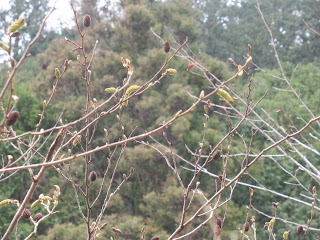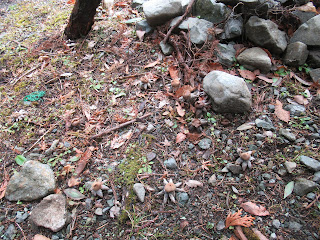 |
| The
rice balls I bought for my lunch from a shop located in front of the Memorial Garden. Pure vegan, and De-Li-Cious!! |
 |
| This is the shop, called Maru Sho-ya. Please try! |
The opened part of the Meiji Memorial Garden is where the summer houses stand for PM Okuma Shigenobu 大隈重信 (8th and 17th PM) and Foreign Minister (1892-1896) Mutsu Munemitsu 陸奥宗光. The current plan also includes the residence of the final Crown Prince of Korean Empire, Prince Yi Un 李垠, (i.e. the summer house of 1st, 5th, 7th, and 10th Japanese PM Ito Hirobumi 伊藤博文). The Crown Prince’s part is currently undergoing complete reconstruction so that we cannot enter the site at all. The west of the Prince’s seat was also a summer house of PM Saionji Kinmochi 西園寺公望 (12th and 14th PM), and later of the 14th Governor of BOJ, Ikeda Shigeaki 池田成彬. The area is at the moment excluded from the plan for Meiji Memorial Garden, but their mansion which is a rare amalgam of Art Deco and English Tudor style, still stands. The rumor is, the site will eventually be included in the National Garden. Let us see …
 |
| The
map of the Memorial Garden. The section with icons of trees and information center is open to the public. |
 |
| The former
residence for Prince Yi Un is under complete reconstruction. |
 |
| The
mansion standing next to the Crown Prince’s place. Yeah, it’s closed. |
The two summer houses for PM Okuma and Minister Mutsu are presently closed for earthquake reinforcement work. At least now, between the structures there is no wall or the like at all. We can enjoy the Gardens of these two guys as one. I guess when the houses are open to visitors we will know how two families arranged their neighborhood when they were here ... Compared with Hotel New Otani’s garden in the center of Tokyo we’ve visited before (; my post on September 20, 2019), the Gardens of Okuma and Mutsu are definitely open and relaxed. Indeed, New Otani Garden was the property of viceroy feudal lord Ii 井伊家 who commuted from there to his office in Edo Castle for Tokugawa Shogunate. This one in Oiso was for summer houses. Beyond the forest (and Seisho Bypass Motorway) is the sand beach facing the vast Pacific Ocean. It should have a peaceful atmosphere. Even so, the character of the place might be due to the spirit of the era, rapidly industrializing Japan before the World War I ...
 |
| PM
Okuma’s summer house. He loved to have party here every weekend. |
 |
| Minister Mutsu’s summer house |
 |
| We
walk straight through the ocean facing section of PM Okuma’s place, and find this Minister Mutsu’s. There’s no barrier at all. |
 |
| Here
and there they provide panels describing how the owners used this place. They provide English version as well. |
Since Oiso Town is on the crushing point of Eurasian and Philippines Plates, the beachfront area has creased-up edges of Eurasian Plate as continuous small hills running parallel to the shore. The Garden uses the peculiar geographic feature cleverly. The summer houses stand at the “hill top,” and the rock gardens and planting design expand over the slopes going down and up before descending to the beach. Mutsu’s Garden has an artificial water cascade (which is now dry due to the construction work) with strategically located rocks to recreate “ideal” scenery of deep mountain. The strolling path is surrounded by azaleas, roses, citrus trees, and the others with lawns. Here and there are formidable black pines and camphor trees. A part of the garden has both black and red pines both of which were well taken care of to admire the contrast of black and red trunks. I suppose the gardeners here have been superb as they nurtured beautiful red pines in such a humid sea front. (Red pines normally thrive in dry mountainous area.) This tells wealth and power of the former owners of the Garden.
 |
| The
Garden. We can go up to the point where the sheet covers the route. Beyond it is under construction now. |
 |
| The color contrast of boughs of red and black pines … |
 |
| I
guess this place has lots of flowers of Azalea in two months … |
 |
| Beautiful Camelias |
 |
| The
artificial cascade in Mutsu’s garden. I return here when the water flow is resumed … |
Minister Mutsu was a protagonist to conclude the first Sino-Japanese War / War of Jiawu (1894-95). Though, at the zenith of his career his tuberculosis became serious, which made him quit the post in 1896. After resignation, he spent long time in his summer house in Oiso, and visited Hawaii for recuperation. Unfortunately, he did not last long and died in 1897. Er, well, Hawaii is, and perhaps was, a paradise on earth. But Mutsu’s Oiso Garden also could have been gorgeous and restful. Why did he have to travel such a long way to Waikiki with his sick lungs …? How was Japan at the turn of the century …? Did people need paradise that much …? I wonder.
I then noticed these towering pines have many tags stamped on their trunks. What are they? Some keeps legible words written on them. They say “Immunization, (day)/(month)/(year); Drug name, xxx; Methods of administration, yyy; Administrator, zzz Co.” Wow. They are vaccination passport against pine wilt. I cast my eyes to the outside corner of Okuma’s Garden. There is a tall, but withered pine tree. All the beautiful pines here are struggling to cope with the attack of pine wood nematode … Whatever the Prime Ministers or Diplomatic Treaties, killing diseases by bacterium, nematode, or virus, have been here for more than centuries … When my turn comes, I’m going to be vaccinated against COVID-19!
 |
| Or, dying … |
 |
| This
one stood outside the entrance of the Garden. Experienced veteran … |
Meiji Memorial Garden
Showa Kinen Park Oiso Office, Kanto Regional Bureau,
Ministry of Land, Infrastructure, Transport, and Tourism
国土交通省関東地方整備局
国営昭和記念公園事務所大磯分室
Phone: 0463-79-8700
Oiso Town Hall 大磯町役場
183 Higashikoiso, Oiso-cho, Naka-gun, Kanagawa, 255-8555
〒255-8555 神奈川県中郡大磯町東小磯183
Phone: 0463-61-4100
Fax: 0463-61-1991
http://www.town.oiso.kanagawa.jp/isotabi/index.html http://www.town.oiso.kanagawa.jp/oisomuseum/index.html











































